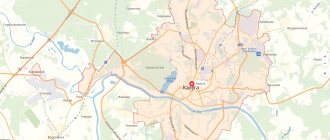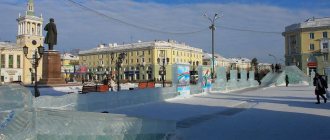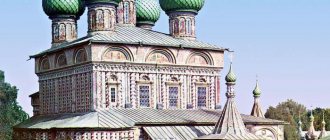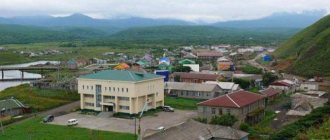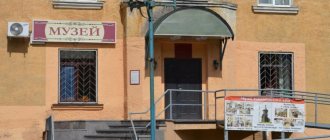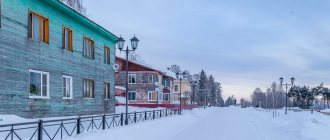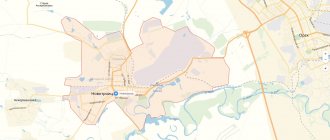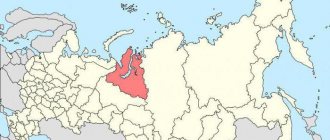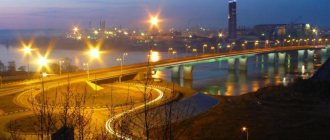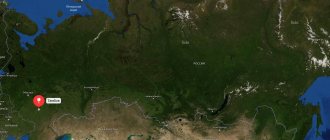The city of Voronezh was founded on the coast of the Vorona River in the 16th century. It is located in the European part of Russia, in the south. A satellite map of Voronezh allows you to see that the city has various relief forms. One part of the city is located on hilly terrain, and the second on a flat plain. Using the map, it’s easy to navigate the city streets and plan your route for the whole day. Almost the entire city is located on the Oksko-Don Plain. You can learn about the topography of a given area by the street names. For example, Kuban Mountain, Meat Mountain or Craft Mountain.
Map of Voronezh with streets
Using a map of Voronezh by district, it is easy to find any district of the city, and there are 6 of them in the city.
- One of the largest districts is Zheleznodorozhny .
- On the right side of the Voronezh Reservoir is the Central District .
- Sovetsky is also located there .
- And the Kominternovsky district is located on the right side of the river.
- The smallest can be called Leninsky district .
- On the left side of the river is the Levoberezhny .
The structure of the districts on the right bank is characterized by a more developed economy; the majority of the population lives here. Yandex maps of Voronezh will help you find any part of the city. The right bank areas represent the cultural center of the city. Entertainment and cultural institutions are concentrated there.
There are many areas in the city center that are popularly named because of businesses or other important facilities.
One of these areas is a residential area, it belongs to the young areas and is located in the northern part of the city. Using a map of Voronezh with streets in good quality, you can very easily find any desired object.
On the left bank there are areas inhabited by former factory workers.
Voronezh can be called an important transport center. There are two railway stations on the territory of the city.
The map of Voronezh allows you to see all highways. Voronezh is crossed by the Don highway. The city also has several bus stations located in different areas.
The airport is located a few kilometers from the city limits. It makes regular flights both to Moscow and to various Russian cities.
Within the city limits there are minibuses, trolleybuses and numerous buses. The banks of the Voronezh Reservoir are connected through a dam, the Otrozhensky Bridge and several road bridges. The North Bridge has an original two-tier design. Using Voronezh Routes you can easily find any bridge on the map.
Climate of the Voronezh region
The region where the city of Voronezh is located is located on the territory of the European part of Russia, on the border of the Oka-Don Upland. Due to this, the terrain of the region is hilly and rugged.
As for the climate, the region where the city of Voronezh is located belongs to the temperate climate zone with moderately frosty winters, which are considered slightly warmer than Moscow, and warm summers.
In winter, abundant snow cover remains stable throughout the entire Voronezh region, which, however, does not form earlier than mid-December. Quite often in winter the temperature drops to twenty degrees below zero. Such temperatures can last up to a week or more. Among the summer months, July is considered the hottest, at the beginning of which temperatures can reach thirty degrees. However, in general, summers are considered moderately warm and dry. It is worth noting that the average annual temperature in the region where Voronezh is located is 6.5 degrees Celsius.
Map of Voronezh with house numbers
Many architectural monuments were destroyed during the Great Patriotic War. Many of them have undergone thorough reconstruction. Currently in Voronezh there are many ancient buildings and cultural sites that all travel lovers enjoy visiting.
More than 200 buildings have been preserved on the territory of the city, which are monuments of architectural urban planning.
A map of Voronezh with streets and houses will help you find the most interesting sights.
- The bell tower belonging to the Alekseevo-Akatovsky Monastery and the Admiralty Church are the oldest objects in Voronezh.
- It is also worth visiting the Church of the Intercession of the Virgin Mary, built in the classical style, and the Tikhvin-Onufriensky Church, built in the Baroque style.
- Walking along the streets, you can see old mansions. These are the houses of the Nechayevs, Tulinovs and Nenarkomova.
- Various monuments to great people can be found using a map of Voronezh with streets. This is the famous monument to Peter I, and monuments dedicated to the poets Nikitin and Koltsov, as well as monuments to the victims of the White Terror, as well as the famous monument to Glory.
- The most beautiful places for tourists to visit are concentrated in the central part of the city. These include the Arsenal Museum.
- One of the mysterious places is considered to be the castle of Princess of Oldenburg.
- The best place for walking is Petrovsky Square.
There are also many entertainment and shopping places in Voronezh. These include Petrovsky Passage, Balagan City and Parnas.
Where to eat: cafes and restaurants
| Name | Address | Sample check |
| Via Bar Luskoni | st. 20 years of Komsomol, 54a | 700-800 |
| Old city | st. Pushkinskaya, 2 | 1200-1500 |
| Route 66 | st. Lizyukova, 50 | from 600 |
| Harmonic | st. Karla Marksa, 94 | from 800 |
| PLATON | Pobeda Boulevard, 50 | from 1000 |
| Italian courtyard | st. Kropotkina, 10a | 500-1000 |
| Uchkara | Revolution Avenue, 46 | from 750 |
Economy and industry of Voronezh
A map of Voronezh with house numbers will allow you to find any business in the city. This is a city with an excellently developed industry. The most famous enterprises include the Aircraft Manufacturing Society, the Ceramic Plant, Rudgormash and the Mechanical Plant.
Also within the city there is a large enterprise “Chernozemye Furniture”, which produces environmentally friendly furniture.
Also, new shopping centers and various markets are appearing in Voronezh. Currently, there are more than 60 different markets in the city. Among them there are universal, specialized and agricultural fairs.
Founding of Voronezh
The region where Voronezh is located has been called the Voronezh province since 1725, which occupied vast areas from Azov proper in the south to Murom in the north. The city gradually developed, a theological seminary appeared in which the lower clergy were trained.
Like all Russian cities, Voronezh was built up mainly with wooden houses and this created a high risk of fires, the worst of which happened on May 10, 1748. The entire historical center, located on the river bank, was destroyed by fire, but soon the city was rebuilt again on the site of the current University Square.
The city also occupied an important place during the Patriotic War of 1812, when recruits arrived in the city from nearby provinces to join the resistance. The region where the city of Voronezh is located was not occupied by enemy troops at that time, so it was here that collections of money and uniforms for volunteers took place.
"Voronezh - Peter's city." How the king turned an inconspicuous fortress into the capital
Exactly 320 years have passed since the first visit of Peter I to Voronezh on Sunday, March 13. From 1696 to 1722, the emperor came to Voronezh 13 times and spent a total of 1.5 years here. Historical facts about the significant role of Peter in the development of the country are widely known, but what influence the tsar-reformer had on Voronezh, residents of the capital of the Black Earth Region do not know so well. At the request of a RIA Voronezh correspondent, local historian, candidate of historical sciences, and writer Nikolai Komolov undertook to fill in the gaps.
Photo - Evgenia Emelyanova
"There's a lot of empty space." How Peter I assessed Voronezh
– Why did Peter I choose Voronezh for the construction of the fleet?
– The Emperor appreciated the advantages of the city’s location - the Voronezh River was navigable (by that time river boats had been floating along it for 100 years), not far from the fortress it flowed into the Don. Secondly, the local population was accustomed to building ships. There were craftsmen and carpenters here who had cut their teeth on the construction of river plows. Their experience could be used to create a navy.
– What did Peter I’s idea give to Voronezh to make it a springboard for building a fleet and capturing Azov?
– Before the tsar’s first arrival in Voronezh, it was an average, not very remarkable town, which did not particularly stand out against the background of similar border fortresses. With the arrival of Peter, the fortress began to change. After all, in order to build a fleet, it was necessary to create the appropriate infrastructure: enterprises for the production of ropes, resin, sails, and iron products. A kind of industrialization began. The quiet town has turned into a fairly powerful industrial center. In addition, workers had to be provided with food, which led to the rapid development of trade.
Photo - Evgenia Emelyanova
– How has the social life of Voronezh changed thanks to Peter I?
– To build the fleet, it was necessary to attract thousands of workers. They were collected from the Urals, Ukraine. Many foreigners came to the city, because for Russia the creation of a navy was unusual. The Dutch, British, Venetians, and Danes came to Voronezh. They all spoke different languages, had different religions (Catholicism, Protestantism of different movements), customs, and culture. So Voronezh turned into a kind of Babylon. And its inhabitants, to some extent, became familiar with the attributes of Western civilization. Churches were built in the shipyard area, and the Assumption Church stood nearby, and all this coexisted perfectly. Yes, there were conflicts. But we can say that Peter created a kind of platform for tolerance on the basis of Voronezh, taught the townspeople that foreigners are “people too,” and you can communicate and work with them. All this, in the end, led to the fact that both the appearance of the city and its perception changed. The word "Voronezh" became known in Europe. Monarchs from different countries knew that Peter was on the Don in some Voronezh and was building a fleet there. And foreign diplomats came here to see Peter. So, by choosing Voronezh, Peter I made a fateful decision. I believe that in the history of our city there were two epochal events - the construction of the fleet and the period of the Great Patriotic War.
– How long did the impulse given by Peter to Voronezh last?
– Shipbuilding in the city lasted 15 years. After an unsuccessful war with Turkey, it had to be curtailed. Petersburg and the Baltic Fleet were building up their forces, and the masters were leaving there. Voronezh in terms of fleet construction began to fade; it continued in Tavrov, Pavlovsk, Novokhopersk. Why did Voronezh continue to develop after Peter the Great? Our city was the economic center of the Don region due to its convenient geographical location - both land and river routes. Eventually, it became a merchant city, but this has little to do with Peter I.
Photo — Vitaly Grass
– Why do you think Peter I had such an influence on our history?
– Attempts to introduce features of Western civilization began in Rus' even before Peter, including under his father Alexei Mikhailovich and brother Fyodor Alekseevich. But Peter had a special temperament, an explosive character, he could not sit still and do one thing. Because of this, the king gave the country a much stronger impetus. Thanks to Peter, the European vector of Russia’s development became irreversible; we could no longer turn in the other direction. And Voronezh occupies a worthy place here. Never again did a head of state spend so much time in the provinces as Peter I did in Voronezh. If you add up all 13 of Peter’s visits, it turns out that he spent almost a year and a half with us. At this time, Voronezh became the center of political decision-making, the unofficial capital of Russia. The decade and a half at the turn of the 17th-18th centuries was a very bright period in the history of our city. Of course, Voronezh is Peter’s city. And we can be proud of this.
Volgograd (859.4 sq. km)
Volgograd is a hero city, originally called Tsaritsyn, then Stalingrad for some time. Now it has more than a million inhabitants. The city stands on the Volga, along which ancient trade routes passed. This city forever linked its name with the largest battle of World War II, the Battle of Stalingrad, in which the heroism, courage and unbending will of our soldiers were demonstrated. To perpetuate the memory of this battle, the majestic Motherland monument was erected in Volgograd, which has since become the hallmark of the city.
Border is locked tight
The boyars had reasons for such a decision. These lands were considered a “problem region” at that time. Through them came detachments of Crimean and Nogai Tatars - dangerous warriors and greedy robbers. Cherkassy - Cossacks and other “walking people” of the Ukrainian Wild Field also appeared there.
In addition, the Don became a refuge for numerous fugitives from Russian lands. People were in a hurry to hide from the oppression of the feudal lords, from the miserable life, from the bad character of Ivan the Terrible - there were more than enough reasons to escape. These fugitives ceased to be a “productive force” and turned into a threat to the state, as they often engaged in robbery.
In order to secure the borders and limit the flow of fugitives, it was necessary to have authorities and military force on the Don. The new fortress was designed to solve this problem - it could accommodate a garrison and government institutions. At the same time, the possibility arose of returning desolate, uncontrolled lands to general state use.
Since in this case the construction of the city was a “sovereign matter,” it was organized accordingly. The person responsible for the implementation of the project was appointed - the noble boyar Semyon Fedorovich Saburov. At his disposal were “service” and “working” people from Pereyaslavl (Ryazan), Ryazhsk and other regions. All over the country, volunteers were recruited for the Don - from among the military and artisans. These settlers were promised various benefits and privileges - a common practice of the time.
Semyon Fedorovich Saburov - first governor of Voronezh
Saburov turned out to be an energetic and decisive person and carried out the order zealously. They provided him with funds and workers, and already in the summer of 1586 he was in full swing building fortifications. Thanks to the boyar’s diligence, this year became the founding date of the city. Construction proceeded quickly, fortunately there was no shortage of building materials - Voronezh forests were nearby.
Ufa (707.9 sq. km)
More than 1.2 million people live in modern Ufa, the capital of the Republic of Bashkortostan. If we take into account the population density, then the residents of Ufa live much more freely than other city residents - for each Ufa resident there are more than 600 square meters. m. city. This city is a large economic, scientific, cultural and sports Russian center. The importance of Ufa was emphasized by the meetings of the leaders of the SCO and BRICS held here in 2015. A large share of the city's territory is occupied by green spaces, squares and parks. There are many different monuments in the city.
Kazan (614.2 sq. km)
Unofficially, the capital of the Republic of Tatarstan, Kazan, is called the third Russian capital. This ancient city is more than 1000 years old. It is multinational, 115 nationalities coexist peacefully in Kazan, but the backbone is made up of Russians (48.6%) and Tatars (47.6%). Kazan is a significant cultural, economic, scientific and religious center of Russia, as well as a large river port. Sports in Kazan are also developing very rapidly. The city authorities attach great importance to the development of tourism and encourage the holding of various festivals. The main architectural attraction here is the Kazan Kremlin, which is under UNESCO protection.
Interesting places in the Moscow region that are worth visitingIn such a huge country as Russia there are many beautiful corners. Moreover, many compatriots will not have to travel far, because there are interesting me...
Moscow (2561.5 sq. km)
Moscow is gradually expanding and increasing its area. In 2012, there was a sudden increase in the size of the capital, when it was decided to annex a significant piece of the territory of the Moscow region. Thus, the area of the metropolis now consists of 780 square meters. km located within the Moscow Ring Road (which was traditionally considered Moscow), and the remaining share is the territory of the region located outside the Moscow Ring Road in the south-west direction. More people live in Moscow than in some large European countries (for example, Norway and Finland taken together, about the same number live in Belgium and the Czech Republic). And this is only according to official statistics. In a giant “anthill” there are native Muscovites, people coming for a better life from the Russian hinterland, labor migrants from neighboring countries, and students. Moscow's population growth is driven not by birth rates, but by influx from outside. The main goal of visitors is to earn money.
List of the 15 best attractions in Moscow Noisy, huge, ancient Moscow, thanks to its history, is rich in various attractions and interesting historical places. It's impossible to...
St. Petersburg (1439 sq. km)
This city is the most important economic, cultural and scientific center of the country after Moscow; it is also a major transport hub. The historical center of the city and the historical and architectural monuments located in it and in the suburbs are under UNESCO protection. Therefore, St. Petersburg is one of the most important tourist routes in Russia. In 2015, the city's population exceeded the 5 million mark. In terms of population in Europe, it is second only to Istanbul, Moscow and London. Among the northern cities of the world, it is the largest, as well as the first in Europe among cities that are not capitals. St. Petersburg has the status of a city of federal significance. The population of Leningrad in the 1980s also reached 5 million, but in the crisis years of the 90s there was a depopulation phenomenon - when the mortality rate began to exceed the birth rate, as a result of which the city's population decreased significantly. And only in 2012 it again reached the same 5 million mark, and by 2022 it amounted to almost 5.4 million people.
Orsk (621.3 sq. km)
Orsk is divided into three administrative districts, and its population is only 234.4 thousand people. The city is located in picturesque places - on the spurs of the Ural Mountains. Along the bed of the Ural River flowing through Orsk there is a division into Europe and Asia. It is mainly an industrial city, the second most important in the Orenburg region. It operates in such industries as mechanical engineering, non-ferrous metallurgy, mining, petrochemicals, light and food industries. There are about 4 dozen archaeological sites in Orsk. The local variegated jasper is especially famous, the deposit of which is located right within the city, on Mount Colonel. Orsk jasper has the widest variety of colors and patterns.
Chronological problem
However, despite the existence of a document with precise data on the founding of Voronezh, the date of birth of the city is still periodically disputed. The reasons are the presence in the chronicles of the word “Voronezh” itself and the mention of the existence of a certain fortress on the Don.
The earliest of these mentions dates back to the end of the 12th century. Accordingly, supporters of the theory of the antiquity of the city believe that it appeared in the same century, and then fell into decay as a result of the Mongol invasion. But there is one subtlety in this matter: after all, there is also the Voronezh River! And the most ancient chronicle references can easily be attributed to it, and not to a populated area (especially one that has the status of a city or at least a fortress).
However, although the date of the founding of the city must definitely be attributed to a later period, the territory in the vicinity of modern Voronezh was populated during the era of fragmentation of Russian lands. Formally, it belonged to the Ryazan principality. People settled here even after the Mongol invasion. The presence of swampy flood plains and dense forests on the Don and Voronezh Rivers helped to hide from the Tatars and live in relative safety. Rivers and forests also provided the opportunity to feed themselves.
Russian state in the middle of the 16th century, map
Officially, the year of the founding of Voronezh is determined by a specific document dated March 1, 1586, which refers to the decision of Tsar Fyodor Ioannovich and a group of his associates. The boyars and the tsar considered it necessary to organize the construction of a fortified settlement between the Don and Voronezh rivers.
1980s. Voronezh is 400 years old
In 1986, Voronezh magnificently celebrated the 400th anniversary of the city. For the anniversary, historical and architectural monuments were restored, intensive research work was carried out, and a number of works on the history of the city were published. The restoration was completed and the Assumption Admiralty Church was consecrated.
The Northern Bridge, the only two-tier concrete bridge in the USSR and Europe, was put into operation. A new tram depot No. 3 was opened. The most modern (and last) department store in Voronezh, Rossiya, was built and put into operation.
In 1986, Voronezh was awarded the Order of Lenin. The general development of the city continued.
